A Survey of Marine Coastal Litters around Zhoushan Island, China and Their Impacts
Abstract
1. Introduction
2. Materials and Methods
2.1. Study Sites
2.2. Survey Design
2.3. Data Analysis
3. Results and Discussion
3.1. Sample Statistics
3.2. Classification of Sampled Litters
3.3. Relationship Between Litter and Landform
3.4. Questionnaire Feedbacks
3.5. Discussion
4. Conclusions and Recommendation
Supplementary Materials
Author Contributions
Funding
Institutional Review Board Statement
Informed Consent Statement
Data Availability Statement
Conflicts of Interest
References
- Chen, X.; Gao, Y.Y.; Ling, W.; Liu, Q.; Shen, Q.; An, L.H. Characteristics and Control of Marine Macrolitter in Estuaries of Liaodong Bay. Res. Environ. Sci. 2019, 32, 1959–1965. [Google Scholar] [CrossRef]
- UNEP. Marine Litter: A Global Challenge; United Nations Environment Programme, Nairobi. 2009. Available online: https://wedocs.unep.org/handle/20.500.11822/7787 (accessed on 20 November 2020).
- Elias, S.A. Plastics in the Ocean. In The Encyclopedia of the Anthropocene, 1st ed.; Dominick, D., Michael, G., Eds.; Elsevier: Oxford, UK, 2018; pp. 133–149. [Google Scholar] [CrossRef]
- Consoli, P.; Sinopoli, M.; Deidun, A.; Canese, S.; Berti, C.; Andaloro, F.; Romeo, T. The impact of marine litter from fish aggregation devices on vulnerable marine benthic habitats of the central Mediterranean Sea. Mar. Pollut. Bull. 2020, 152, 110928. [Google Scholar] [CrossRef]
- Sinopoli, M.; Cillari, T.; Andaloro, F.; Berti, C.; Consoli, P.; Galgani, F.; Romeo, T. Are FADs a significant source of marine litter? Assessment of released debris and mitigation strategy in the Mediterranean sea. J. Environ. Manag. 2020, 253, 109749. [Google Scholar] [CrossRef] [PubMed]
- Jambeck, J.R.; Geyer, R.; Wilcox, C.; Siegler, T.R.; Perryman, M.; Andrady, A.; Narayan, R.; Law, K.L. Plastic waste inputs from land into the ocean. Science 2015, 347, 768–771. [Google Scholar] [CrossRef] [PubMed]
- Chen, C.L.; Liu, T.K. Fill the gap: Developing management strategies to control garbage pollution from fishing vessels. Mar. Policy. 2013, 40, 34–40. [Google Scholar] [CrossRef]
- Barnes, D.K.A.; Milner, P. Drifting plastic and its consequences for sessile organism dispersal in the Atlantic Ocean. Mar. Biol. 2005, 146, 815–825. [Google Scholar] [CrossRef]
- Denuncio, P.; Bastida, R.; Dassis, M.; Giardino, G.; Gerpe, M.; Rodríguez, D. Plastic ingestion in Franciscana dolphins, Pontoporia blainvillei (Gervais and d’Orbigny, 1844), from Argentina. Mar. Pollut. Bull. 2011, 62, 1836–1841. [Google Scholar] [CrossRef] [PubMed]
- Consoli, P.; Falautano, M.; Sinopoli, M.; Perzia, P.; Canese, S.; Esposito, V.; Battaglia, P.; Romeo, T.; Andaloro, F.; Galgani, F.; et al. Composition and abundance of benthic marine litter in a coastal area of the central Mediterranean Sea. Mar. Pollut. Bull. 2018, 136, 243–247. [Google Scholar] [CrossRef] [PubMed]
- Consoli, P.; Andaloro, F.; Altobelli, C.; Battaglia, P.; Campagnuolo, S.; Canese, S.; Castriota, L.; Cillari, T.; Falautano, M.; Peda, C.; et al. Marine litter in an EBSA (Ecologically or Biologically Significant Area) of the central Mediterranean Sea: Abundance, composition, impact on benthic species and basis for monitoring entanglement. Environ. Pollut. 2018, 236, 405–415. [Google Scholar] [CrossRef] [PubMed]
- McElwee, K.; Donohue, M.J.; Courtney, C.A.; Morishige, C.; Rivera-Vicente, A. A strategy for detecting derelict fishing gear at sea. Mar. Pollut. Bull. 2012, 65, 7–15. [Google Scholar] [CrossRef] [PubMed]
- Peng, G.; Zhu, B.; Yang, D.; Su, L.; Shi, H.; Li, D. Microplastics in sediments of the Changjiang Estuary. China. Environ. Pollut. 2017, 225, 283–290. [Google Scholar] [CrossRef] [PubMed]
- Yang, J.J.; Xu, L.; Lu, A.X.; Luo, W.; Li, J.Y.; Chen, W. Research progress on the sources and toxicology of micro(nano) plastics in environment. Environ. Chem. 2018, 37, 383–396. [Google Scholar] [CrossRef]
- Wu, X. Developing the Marine Economy and Building a Strong Marine Province. In Chinese Dream and Practice in Zhejiang—Economy. Research Series on the Chinese Dream and China’s Development Path; Pei, C., Xu, J., Eds.; Springer: Singapore, 2019. [Google Scholar] [CrossRef]
- Shao, X.; Jing, C.; Qi, J.; Jiang, J.; Liu, Q.; Cai, X. Impacts of land use and planning on island ecosystem service values: A case study of Dinghai District on Zhoushan Archipelago, China. Ecol. Process. 2017, 6, 27. [Google Scholar] [CrossRef]
- Österblom, H.; Merrie, A.; Metian, M.; Boonstra, W.J.; Blenckner, T.; Watson, J.R.; Folke, C. Modeling social—ecological scenarios in marine systems. BioScience 2013, 63, 735–744. [Google Scholar] [CrossRef]
- Moore, S.L.; Gregorio, D.; Carreon, M.; Weisberg, S.B.; Leecaster, M.K. Composition and distribution of beach debris in Orange County, California. Mar. Pollut. Bull. 2001, 42, 241–245. [Google Scholar] [CrossRef]
- Slavin, C.; Grage, A.; Campbell, M.L. Linking social drivers of marine debris with actual marine debris on beaches. Mar. Pollut. Bull. 2012, 64, 1580–1588. [Google Scholar] [CrossRef] [PubMed]
- Hardesty, B.D.; Lawson, T.J.; van der Velde, T.; Lansdell, M.; Wilcox, C. Estimating quantities and sources of marine debris at a continental scale. Front. Ecol. Environ. 2017, 15, 18–25. [Google Scholar] [CrossRef]
- Šilc, U.; Küzmič, F.; Caković, D.; Stešević, D. Beach litter along various sand dune habitats in the southern Adriatic (E Mediterranean). Mar. Pollut. Bull. 2018, 128, 353–360. [Google Scholar] [CrossRef]
- Cheshire, A.C.; Adler, E.; Barbière, J.; Cohen, Y.; Evans, S.; Jarayabhand, S.; Jeftic, L.; Jung, R.T.; Kinsey, S.; Kusui, E.T.; et al. UNEP/IOC Guidelines on Survey and Monitoring of Marine Litter; UNEP: Nairobi, Kenya, 2009; UNEP Regional Seas Reports and Studies, No. 186, IOC Technical Series No. 83: Xii + 120 pp. [Google Scholar]
- Zhang, G.; Xue, Y.; Zhang, C.; Xu, B.; Cheng, Y.; Ren, Y. Comparison of sampling effort allocation strategies in a stratified random survey with multiple objectives. Aquac. Fish. 2020, 5, 113–121. [Google Scholar] [CrossRef]
- NOWPAP CEARAC. Guidelines for Monitoring Marine Litter on the Beaches and Shorelines of the Northwest Pacific Region. 2007. Available online: https://wedocs.unep.org/bitstream/handle/20.500.11822/27232/ML_Guideline_English.pdf?sequence=8&isAllowed=y (accessed on 20 January 2021).
- Guo, F.; Zhou, P.; Li, Z.; Qin, Y.T. The Distribution, Composition and Sources of Marine Debris in the Coastal East China Sea. Trans. Oceanol. Limnol. 2014, 3, 193–200. [Google Scholar] [CrossRef]
- Simeonova, A.; Chuturkova, R.; Yaneva, V. Seasonal dynamics of marine litter along the Bulgarian Black Sea coast. Mar. Pollut. Bull. 2017, 119, 110–118. [Google Scholar] [CrossRef]
- Kordella, S.; Geraga, M.; Papatheodorou, G.; Fakiris, E.; Mitropoulou, I.M. Litter composition and source contribution for 80 beaches in Greece, Eastern Mediterranean: A nationwide voluntary clean-up campaign. Aquat. Ecosyst. Health Manag. 2013, 16, 111–118. [Google Scholar] [CrossRef]
- Gabrielides, G.P.; Golik, A.; Loizides, L.; Marino, M.G.; Bingel, F.; Torregrossa, M.V. Man-made garbage pollution on the Mediterranean coastline. Mar. Pollut. Bull. 1991, 23, 437–441. [Google Scholar] [CrossRef]
- Da Silva, C.P. Beach carrying capacity assessment: How important is it? J. Coast. Res. 2002, 18, 190–197. [Google Scholar] [CrossRef]
- Alshawafi, A.; Analla, M.; Alwashali, E.; Aksissou, M. Assessment of marine debris on the coastal wetland of Martil in the north-east of Morocco. Mar. Pollut. Bull. 2017, 117, 302–310. [Google Scholar] [CrossRef]
- OSPAR. OSPAR Pilot Project on Monitoring Marine Beach Litter: Monitoring of marine litter in the OSPAR region. 2007. Available online: https://www.ospar.org/documents?v=7058 (accessed on 20 November 2020).
- Pervez, R.; Wang, Y.; Mahmood, Q.; Zahir, M.; Jattak, Z. Abundance, type, and origin of litter on No. 1 Bathing Beach of Qingdao, China. J. Coast. Conserv. 2020, 24, 34. [Google Scholar] [CrossRef]
- Hong, S.; Lee, J.; Kang, D.; Choi, H.W.; Ko, S.H. Quantities, composition, and sources of beach debris in Korea from the results of nationwide monitoring. Mar. Pollut. Bull. 2014, 84, 27–34. [Google Scholar] [CrossRef] [PubMed]
- Derraik, J.G.B. The pollution of the marine environment by plastic debris: A review. Mar. Pollut. Bull. 2002, 44, 842–852. [Google Scholar] [CrossRef]
- Ribic, C.A.; Sheavly, S.B.; Klavitter, J. Baseline for beached marine debris on Sand Island, midway atoll. Mar. Pollut. Bull. 2012, 64, 1726–1729. [Google Scholar] [CrossRef]
- Buhl-Mortensen, P.; Buhl-Mortensen, L. Impacts of bottom trawling and litter on the Seabed in Norwegian Waters. Front. Mar. Sci. 2017, 5, 42. [Google Scholar] [CrossRef]
- Sun, W.; Tang, X.C.; Xu, Y.D.; Zhang, H.J.; Liu, Y.J.; Ma, J.X. The Distribution Composition and Change Characteristics of Marine Debris in the Coastal Area of Shandong Province. Sci. Technol. Eng. 2016, 18, 89–94. [Google Scholar]
- Claereboudt, M.R. Shore litter along sandy beaches of the Gulf of Oman. Mar. Pollut. Bull. 2004, 49, 770–777. [Google Scholar] [CrossRef] [PubMed]
- Hastings, E.; Potts, T. Marine litter: Progress in developing an integrated policy approach in Scotland. Mar. Policy. 2013, 42, 49–55. [Google Scholar] [CrossRef]
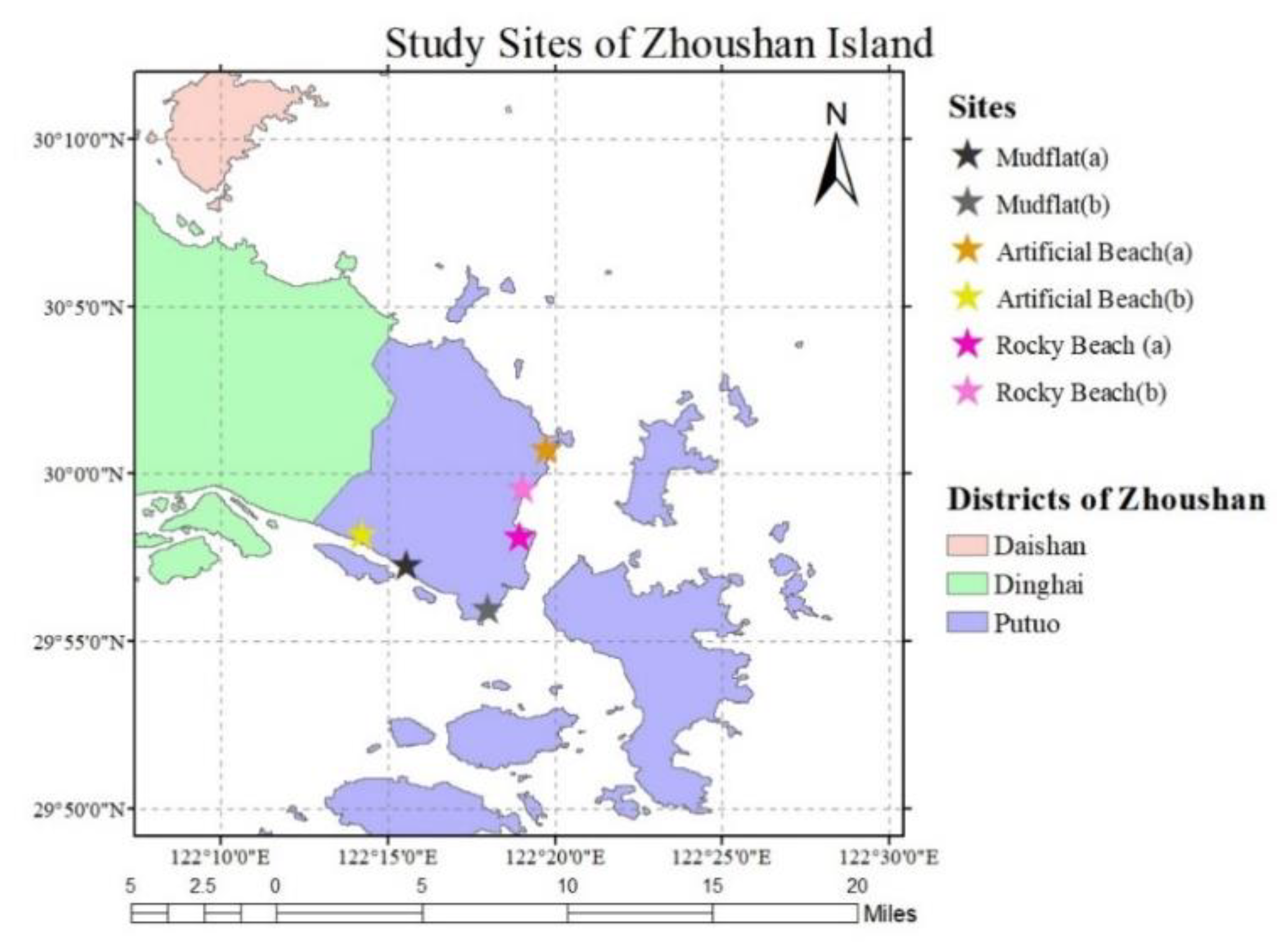

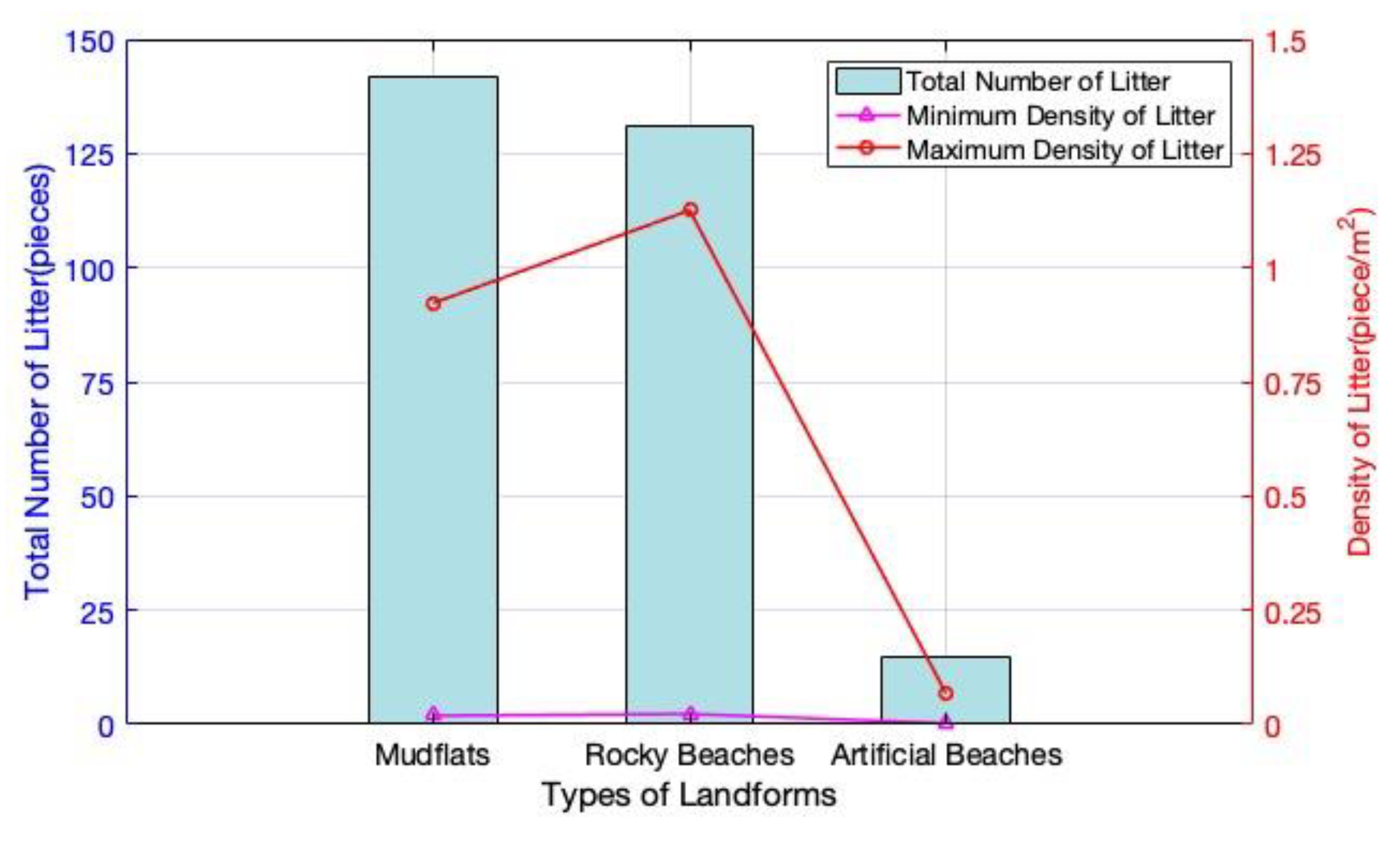
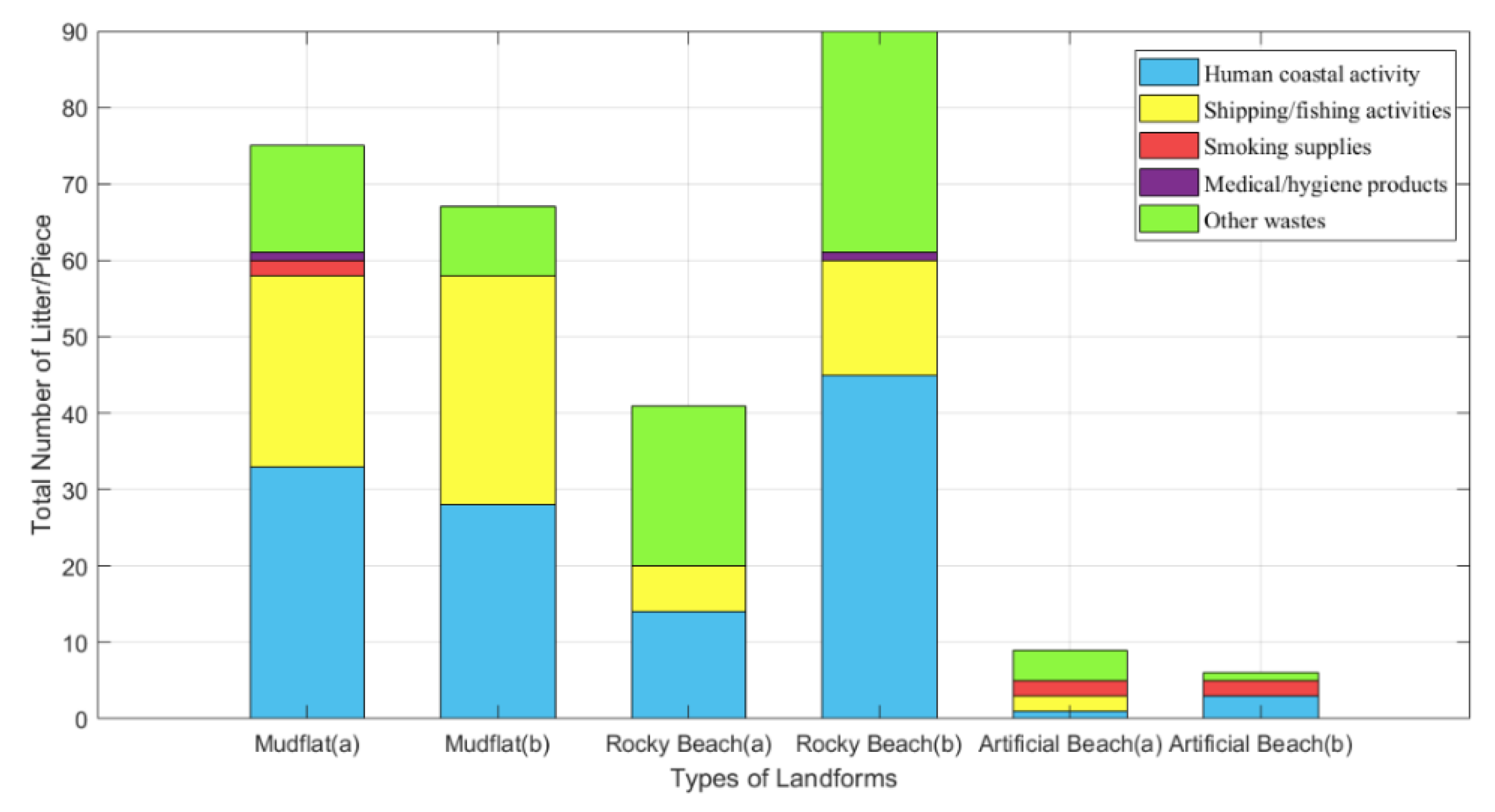
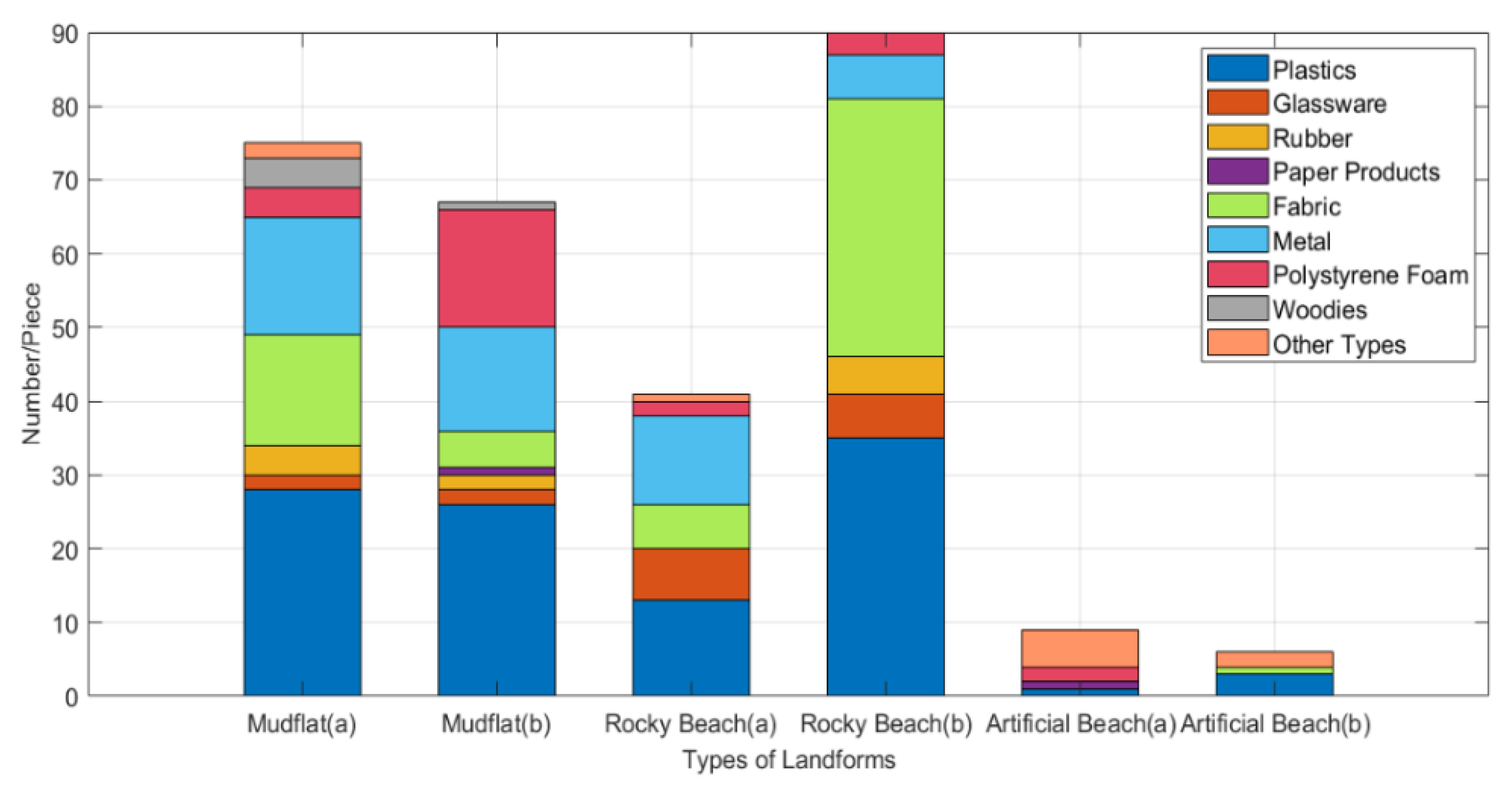

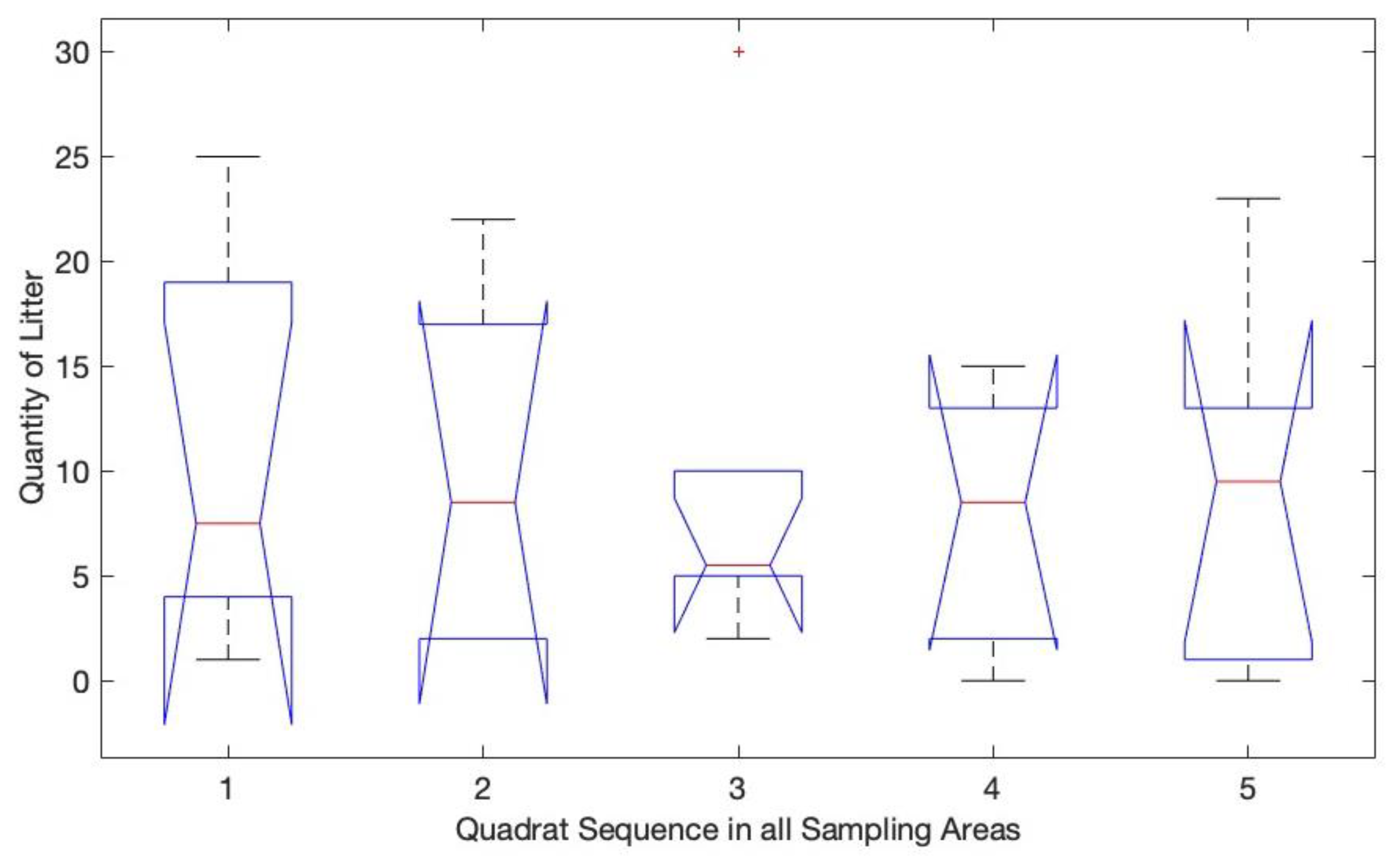
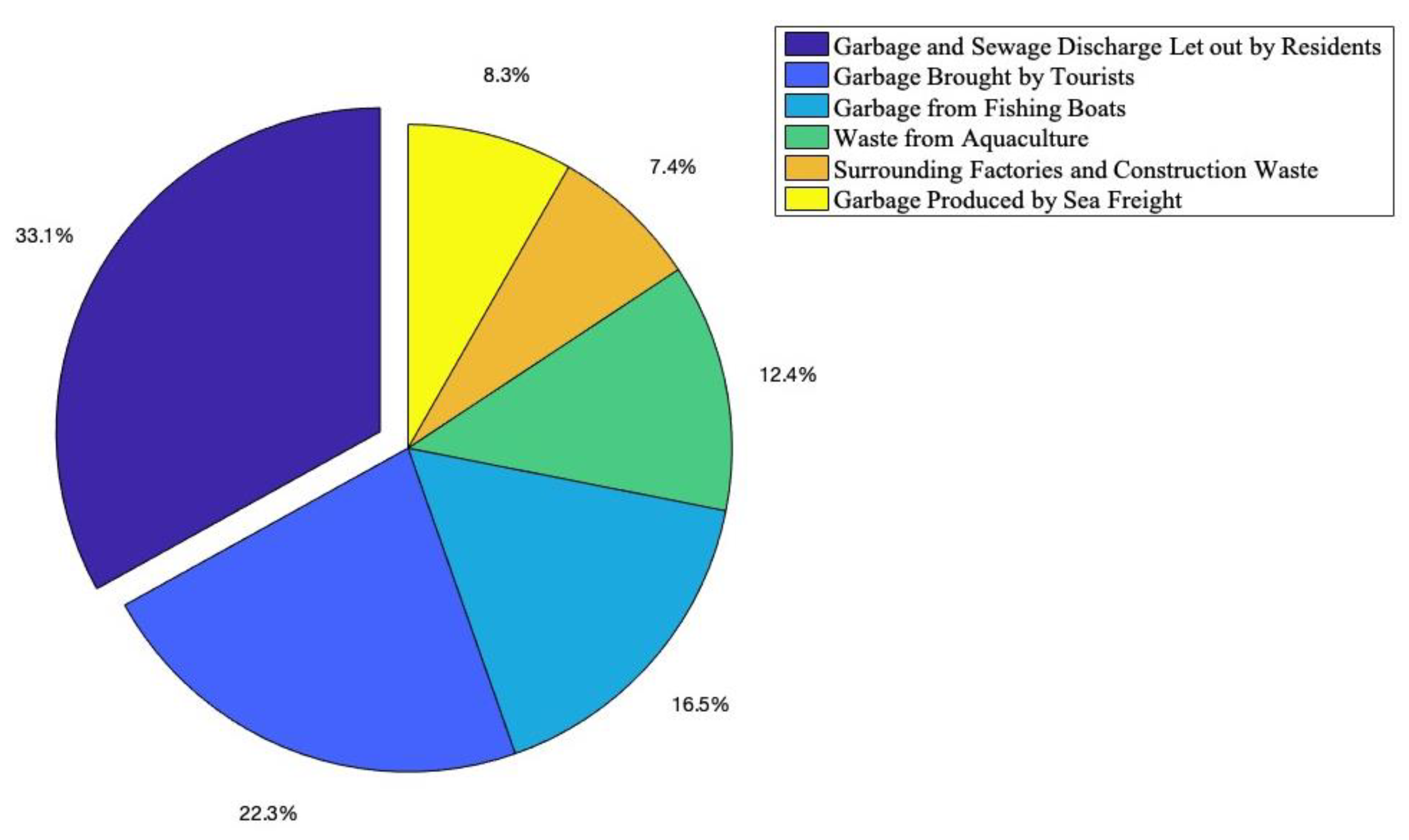
| Materials | Items |
|---|---|
| plastic | plastic bags, plastic bottles, bottle caps, lunch boxes, etc. |
| glass | glass fragments, glass bottles, etc. |
| rubber | tires, rubber gloves, rubber shoes, etc. |
| paper | newspaper, book, disposable paper cup, carton, etc. |
| fabric | old clothes, towels, fishing nets, etc. |
| metal | electrical wiring, cans, paint buckets, etc. |
| polystyrene foam | plastic foam board, etc. |
| wood | desks, chairs, wood waste, etc. |
| others | cigarette ends, sponge, ceramic bowl, etc. |
| Mudflat(a) /Pieces | Mudflat(b) /Pieces | Rocky Beach(a) /Pieces | Rocky Beach(b) /Pieces | Artificial Beach(a) /Pieces | Artificial Beach(b) /Pieces | |
|---|---|---|---|---|---|---|
| Quadrat1 | 25 | 19 | 6 | 9 | 1 | 4 |
| Quadrat2 | 14 | 22 | 3 | 17 | 2 | 0 |
| Quadrat3 | 10 | 6 | 7 | 30 | 5 | 0 |
| Quadrat4 | 13 | 11 | 15 | 11 | 0 | 2 |
| Quadrat5 | 13 | 9 | 10 | 23 | 1 | 0 |
| Sum | 75 | 67 | 41 | 90 | 9 | 6 |
| Mudflats Pieces/m2 | Rocky Beaches Pieces/m2 | Artificial Beaches Pieces/m2 | |
|---|---|---|---|
| Quadrat 1 | 2.2 | 2.75 | 0.25 |
| Quadrat 2 | 1.8 | 1 | 0.1 |
| Quadrat 3 | 0.8 | 1.85 | 0.25 |
| Quadrat 4 | 1.2 | 1.3 | 0.1 |
| Quadrat 5 | 1.1 | 1.65 | 0.05 |
| Mean ± SD | 1.42 ± 0.57 | 1.71 ± 0.67 | 0.15 ± 0.09 |
| Mudflat(a) /Pieces | Mudflat(b) /Pieces | Rocky Beach(a) /Pieces | Rocky Beach (b) /Pieces | Artificial Beach(a) /Pieces | Artificial Beach(b) /Pieces | |
|---|---|---|---|---|---|---|
| Human Coastal Activities | 33 | 28 | 14 | 45 | 1 | 3 |
| Shipping/ Fishing Activities | 25 | 30 | 6 | 15 | 2 | 0 |
| Smoking Supplies | 2 | 0 | 0 | 0 | 2 | 2 |
| Medical/ Hygiene Products | 1 | 0 | 0 | 1 | 0 | 0 |
| Other Wastes | 14 | 9 | 21 | 29 | 4 | 1 |
| Sum | 75 | 67 | 41 | 90 | 9 | 6 |
Publisher’s Note: MDPI stays neutral with regard to jurisdictional claims in published maps and institutional affiliations. |
© 2021 by the authors. Licensee MDPI, Basel, Switzerland. This article is an open access article distributed under the terms and conditions of the Creative Commons Attribution (CC BY) license (http://creativecommons.org/licenses/by/4.0/).
Share and Cite
Ma, X.; Zhou, Y.; Yang, L.; Tong, J. A Survey of Marine Coastal Litters around Zhoushan Island, China and Their Impacts. J. Mar. Sci. Eng. 2021, 9, 183. https://doi.org/10.3390/jmse9020183
Ma X, Zhou Y, Yang L, Tong J. A Survey of Marine Coastal Litters around Zhoushan Island, China and Their Impacts. Journal of Marine Science and Engineering. 2021; 9(2):183. https://doi.org/10.3390/jmse9020183
Chicago/Turabian StyleMa, Xuehua, Yi Zhou, Luyi Yang, and Jianfeng Tong. 2021. "A Survey of Marine Coastal Litters around Zhoushan Island, China and Their Impacts" Journal of Marine Science and Engineering 9, no. 2: 183. https://doi.org/10.3390/jmse9020183
APA StyleMa, X., Zhou, Y., Yang, L., & Tong, J. (2021). A Survey of Marine Coastal Litters around Zhoushan Island, China and Their Impacts. Journal of Marine Science and Engineering, 9(2), 183. https://doi.org/10.3390/jmse9020183







